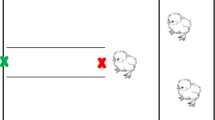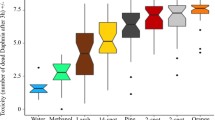Abstract
Aposematic animals use anti-predator defence mechanisms such as distastefulness coupled with distinctive odours, sounds, or colour visual signals to predation from domestic chicks we show that the protective value of such visual warning displays is enhanced by increasing size of the signal pattern elements and decreased by pattern asymmetry. These results provide the first experimental evidence that predation may select for individual symmetry of visual warning displays, and concur with earlier demonstrations that asymmetric signals are more difficult to detect, learn, and remember, compared to symmetric signals. Collectively, our findings suggest that prey species possessing warning coloration should be subjected to selection for large and symmetric pattern elements.
Similar content being viewed by others
References
Alatalo, R.V. and Mappes, J. (1996) Tracking the evolution of warning signals. Nature 382, 708–709.
Attneave, F. (1954) Some informational aspects of visual perception. Psychol. Rev. 61, 183–193.
Blest, A.D. (1957) The function of eyespot patterns in the Lepidoptera. Behaviour 11, 209–256.
Brakefield, P.M. and Breuker, C.J. (1996) The genetical basis of fluctuating asymmetry for developmentally integrated traits in a butterfly eyespot pattern. Proc. R. Soc. Lond. B 263, 1557–1563.
Coppinger, R.P. (1969) The effect of experience and novelty on avian feeding behaviors with reference to the evolution of warning coloration in butterflies. Part I: reactions of wild-caught adult blue jays to novel insects. Behaviour 35, 45–49.
Coppinger, R.P. (1970) The effect of experience and novelty on avian feeding behaviors with reference to the evolution of warning coloration in butterflies. Part II: reactions of naive birds to novel insects. Am. Nat. 104, 323–335.
Cott, H.B. (1940) Adaptive Coloration in Animals. Methuen, London, UK.
Delius, J.D. and Nowak, B. (1982) Visual symmetry recognition by pigeons. Psychol. Res. 44, 199–212.
Edmunds, M. (1974) Defence in Animals: a Survey of Anti-Predator Defences. Longman, Harlow, Essex, UK.
Endler, J.A. (1991) Interactions between predators and prey. In J.R. Krebs and N.B. Davies (eds) Behavioural Ecology an Evolutionary Approach, 3rd edn. Blackwell, Oxford, UK, pp. 169–196.
Gallup, Jr. G.G. (1977) Tonic immobility: the role of fear and predation. The Psychol. Record 1977. 41–61.
Gamberale, G. and Tullberg, B. (1996) Evidence for a peak-shift in predator generalization among aposematic prey. Proc. R. Soc. Lond. B 263, 1329–1334.
Gittleman, J.L. and Harvey, P.H. (1980) Why are distasteful prey not cryptic? Nature 286, 149–150.
Guilford, T. (1990) Evolutionary pathways to aposematism. Acta Oecologica 11, 835–842.
Guilford, T. and Dawkins, M.S. (1991) Receiver psychology and the evolution of animal signals. Anim. Behav. 42, 1–14.
Hoffman, A.A. and Parsons, P.A. (1994) Evolutionary Genetics and Environmental Stress. Oxford University Press, Oxford, UK.
Horridge, G.A. (1996) The honeybee (Apis mellifera) detects bilateral symmetry and discriminates its axis. J. Insect Phys. 42, 755–764.
Kirkpatrick, M. and Rosenthal, G.G. (1994) Symmetry without fear. Nature 372, 134–135.
Marples, N.M. and Roper, T.J. (1996) Effects of novel colour and smell on the response of naïve chicks towards food and water. Anim. Behav. 51, 1417–1424.
Moodie, G.E.E. and Reimchen, T.E. (1976) Phenetic variation and habitat differences in Gasterosteus populations of the Queen Charlotte Islands. Syst. Zool. 25, 49–61.
Møller, A.P. (1993) Female preference for apparently symmetrical male sexual ornaments in the barn swallow Hirundo rustica. Behav. Ecol. Sociobiol. 32, 371–376.
Møller, A.P. (1996) Sexual selection, viability selection, and developmental stability in the domestic fly Musca domestica. Evolution 50, 746–752.
Møller, A.P. and Nielsen, J.T. (1997) Differential predation cost of a secondary sexual character: sparrowhawk predation on barn swallows. Anim. Behav. 54, 1545–1551.
Møller, A.P. and Pomiankowksi, A. (1993a) Fluctuating asymmetry and sexual selection. Genetica 89, 267–279.
Møller, A.P. and Pomiankowksi, A. (1993b) Punctuated equilibria or gradual evolution: fluctuating asymmetry and variation in the rate of evolution. J. Theor. Biol. 161, 359–367.
Møller, A.P. and Swaddle, J.P. (1997) Asymmetry, Developmental Stability and Evolution. Oxford University Press, Oxford, UK.
O'Brian, R.G. and Kaiser, M.K. (1985) MANOVA method for analyzing repeated measures designs: an extensive primer. Psychol. Bull. 97, 316–333.
O'Brien, T.J. and Dunlap, W.P. (1975) Tonic immobility in the blue crab (Callinectes sapidus, Rathbun): its relation to threat of predation. J. Comp. Physiol. Psychol. 89, 86–94.
Osorio, D. (1996) Symmetry detection by categorization of spatial phase, a model. Proc. R. Soc. Lond. B 263, 105–110.
Poulton, E.B. (1890) The Colour of Animals: their Meaning and Use. Kegan Paul, Trench, Trubner, London, UK.
Rice, W.R. and Gaines, S.D. (1994) Extending nondirectional heterogeneity tests to evaluate simply ordered alternative hypotheses. Proc. Natl. Acad. Sci. USA 91, 225–226.
Roper, T.J. and Cook, S.E. (1989) Responses of chicks to brightly colored insect prey. Behaviour 110, 276–293.
Roper, T.J. and Redstone, S. (1987) Conspicuousness of distasteful prey affects the strength and durability of one-trial avoidance learning. Anim. Behav. 35, 739–747.
Rowe, C. and Guilford, T. (1996) Hidden colour aversions in domestic chicks triggered by pyrazine odours of insect warning displays. Nature 383, 520–522.
Rowe, L., Repaski, R.R. and Palmer, A.R. (1997) Size-dependent asymmetry: fluctuating asymmetry versus antisymmetry and its relevance to condition-dependent signalling. Evolution 51, 1401–1408.
Sargent, T.D. (1990) Startle as an anti-predator mechanism, with special reference to the underwing moths, (Catocala). In D.L. Evans and J.O. Schmidt (eds) Insect Defences — Adaptive Mechanisms and Strategies of Prey and Predators. State University of New York Press, Albany, USA, pp. 229–249.
Schwabl, U. and Delius, J.D. (1984) Visual bar length discrimination threshold in the pigeon. Bird Behav. 5, 118–121.
Swaddle, J.P. (1997) Developmental stability and predation success in an insect predator-prey system. Behav. Ecol. 8, 433–436.
Tinbergen, N. (1974) Curious Naturalists. Penguin Education, Harmondsworth, The Netherlands.
Author information
Authors and Affiliations
Rights and permissions
About this article
Cite this article
Forsman, A., Merilaita, S. Fearful symmetry: pattern size and asymmetry affects aposematic signal efficacy. Evolutionary Ecology 13, 131–140 (1999). https://doi.org/10.1023/A:1006630911975
Issue Date:
DOI: https://doi.org/10.1023/A:1006630911975




